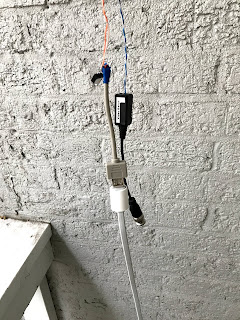Recently I embarked on replacing all a friend's old cameras with some Nest cameras. Unfortunately, the cameras they had were wired up with Ethernet wire so that the only wiring available was custom wiring using 12V. I love the Nest Outdoor Cameras but I don't know why they don't have a PoE option. I didn't want to rewire parts of the house nor have the unsightly nest power cord.
I decided to make my own and figured I would share the details for others who want to avoid the power cord (Note: This will probably void your nest cam warranty).
Above is what the original camera wiring looked like. Two wires for power (12V) and two for data.
You might think, okay just change the power supply on the other side to 5V and call it a day. Unfortunately, Ethernet wire doesn't support 5V very well. When a load is applied (1.5A for the Nest) over a distance, the voltage drops and the nest cam doesn't work.
So, at first, I figured, let's just throw a voltage regulator on there and it should be fine (I used a LM7805). This is shown below. However, this was getting pretty hot and I was worried about it not lasting for several years.
I ended up finding the perfect circuit for this on Amazon here.
It's a LM317 Adjustable Linear Regulator Converter Power Supply with a heat sink and everything you already need. Next, I just rotated the adjustable knob until I read 5V to prep them.
Finally, I got some female USB ports here and soldiered them to the output of the power supply module as shown below.
Here is the final output. A clean nice ethernet based Nest solution. Hopefully Nest comes out with some sort of a PoE solution. However, f you are looking to do this before then, the links above should be all you need to replicate it. This should work for any supply over 9V up to the voltage regulator input limit so you aren't locked in to a 12V only solution like mine.
Feel free to contact me for any questions or if you have products or ideas you think I should try. Places you can find me





Of course you did.
ReplyDelete